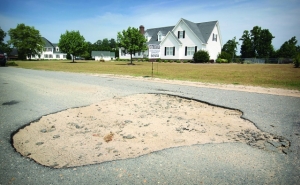Subdivision residents ask for help with pothole problem on key street
By Ty Johnson
Published in News on June 20, 2011 1:46 PM

News-Argus/MICHAEL K. DAKOTA
Residents in a subdivision off Buck Swamp Road are debating who should fix the potholes on East April Lane.
For months now, Bill Edmundson said not a week has gone by without him finding a muffler or a hubcap in his yard.
That's because, he said, the paved road in front of his home on East April Lane is so cratered that it looks more like the surface of the moon than a drivable road.
So now those driving by his house likely have noticed something else in his yard, along with the strewn automobile parts -- a sign asking for someone to "Fix these holes."
The sign notes that the road maintenance is not the responsibility of the homeowners, but the subdivision developer, Bill Lane. It also lists a phone number for Mike Kelly at Lane Tree Development for other concerned residents to call.
So just whose responsibility is the street's maintenance? County Planning Director Connie Price said it lies with the homeowners at this point. The North Carolina Depart-ment of Transportation didn't take over the maintenance of the road when the development was created, not an uncommon problem, he added.
"There is a subdivision ordinance that the roads must be built to NCDOT standards," Price said. "They are issued certifiications that they are built to those standards at the time the subdivision is approved."
Price said maintenance must be provided for a year by the developer, at which time the homeowners or developer can petition the state to take over the maintenance.
The standards that must be met include housing density -- there must be two occupied houses per tenth of a mile -- and road condition, said Chris Pendergraph, the district maintenance engineer.
"The purpose of that is that state doesn't want to assume responsibility of a road that is in disrepair," he said.
The request to the state results in an inspection by the NCDOT and a "punchlist" for residents and the developer indicating what they can do to bring the road up to state standards.
"It can vary from $200 to repaving the entire street," Pendergraph said.
But sometimes the request is never made.
Whether the request was made and denied or never made at all back when the development was begun in the mid-1990s, the road fell victim to the wear and tear of being a cut-through for commuters coming from Fallingbrook and other northwestern areas of the county on their way to the city.
"Some get taken over by the state because property owners or developers stay on top of it," Price said. "But it requires ongoing maintenance just like your house would."
And after more than a decade-and-a-half of use, the craters and potholes that plague motorists developed, eventually getting to the point that Edmundson had had enough.
He called Kelly and was told that Lane had agreed to repave the road if the residents would come together to form a homeowners association to meet the state standard. Lane has since drafted a letter to residents indicating this offer was valid.
But an occurence at a similar property owned by Lane has Edmundson convinced the deal won't work.
In the Red Oak subdivision, a punchlist indicated that there were four infractions preventing the state from taking over the road maintenance, including one homeowner who had erected brick abutments along the entrace to his driveway, too close to the road for the state to take it over. Because the one homeowner refused to take down his brick walls, the state would not take over the streets, even though the other three issues had been addressed.
Edmundson anticipates those brick walls could be a problem in his subdivision, too.
"The majority of people in the neighborhood would be willing to make corrections, but the biggest thing is the driveway abutments," he said. "If they knew, they would be willing to knock them down or back them up, but all it would take is one person.
"I don't own the road so how can it be my responsibility to maintain it?"
But, Pendergraph said, as it stands, the maintenance of the public right-of-way is no one's responsibility.
"There's no one entity tied or bound to the maintenance of the road," he said. "In these situations, the residents are left to fend for themselves."
And as far as the holdouts are concerned, Pendergraph said the state doesn't care who performs the repairs, so long as the road meets its standards.
"We don't care if it's the homeowners association, the developer or just one property owner," he said. "As long as it's in an acceptable state of maintenance."
Been applied for numerous times but they always get turned down.
Lane
safety for the public
priorities for a subdivision
